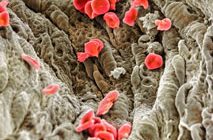How blood is used
About Blood
Whole blood
This is rarely used these days, only really in instances of severe blood loss. It’s usually separated into its individual components.
Red cells
These are used in the treatment of all kinds of anaemia which can’t be medically corrected, such as when rheumatoid arthritis or cancer is involved, when red cells break down in the newborn and for sickle cell disease.
They’re also essential to replace lost red cells due to blood loss in accidents, surgery and after childbirth.
Platelets
Platelets can be used in bone marrow failure, post transplant and chemotherapy treatments, and leukaemia. Platelets can be of huge benefit to the recipient.
Plasma
Fresh frozen plasma is used after obstetric loss of blood (which is usually childbirth), during cardiac surgery, and to reverse any anti-coagulant treatment.
It’s also used to replace clotting factors after massive transfusions or when they are not being sufficiently produced, such as liver disease.
And then there’s processed plasma, which has several important uses.
For instance, it is used in the treatment of haemophilia and for treating sufferers of Christmas disease, a life-threatening form of haemophilia.
Processed plasma is also used to help produce stronger antibodies against diseases like tetanus, hepatitis, chickenpox and rabies.
It also helps generate anti-D, which is used for RhD negative pregnant women carrying RhD positive babies.
Additionally there is a protein called albumin contained in plasma, which is extremely beneficial for burn victims.
Why blood is vital even for the dying
Everyone knows blood is literally a lifesaver for those who’ve been in an accident or need it to help survive treatments and operations. But for some, whose illness has no cure and that last battle they face just can’t be won, a blood transfusion can help to improve their quality of life during their final months, weeks or even days.
Karen Clarke, a Community Nurse who gives transfusions to the terminally ill in their own homes, says, “These vital transfusions give patients a better quality of life. It gives them the energy and ability to enjoy this precious, final time with their families.
But this time is often a gift that only blood can provide. In some serious accidents, its use can mean that a critically ill patient can stay alive long enough for their loved ones to reach the hospital to see them, one last time.
Blood transfusion
A blood transfusion is a procedure in which blood is given via an intravenous line into the blood vessels.
Top uses of blood*
- Surgical 30%
- Haematology 18%
- Gastro intestinal bleeding 11%
- Anaemia 30%
- Maternity 6%
- Other 5%
*From research in 2009. Blood usage will vary between hospitals because of their particular specialties.


